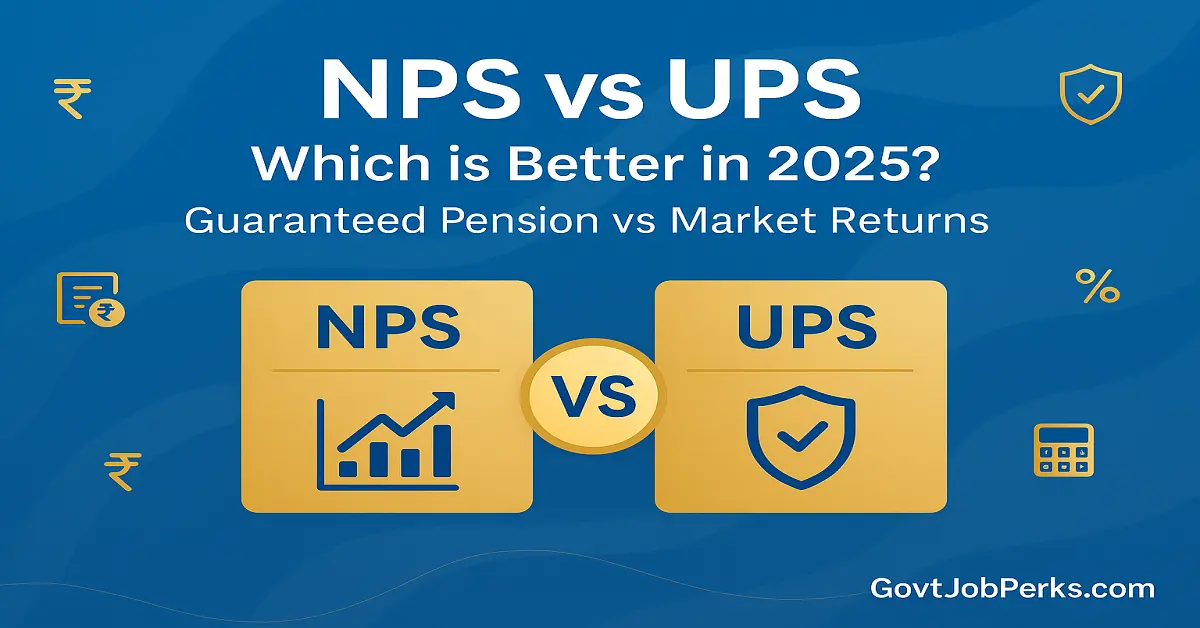NPS vs UPS – Which is better for government employees in 2025? This is a hot topic today. The National Pension System (NPS) has been around for years, but the Unified Pension Scheme (UPS), introduced under the NPS Rules, 2025, has changed the pension landscape for central and state government employees. Let’s break down the differences, pros and cons, and see which works best for you.
What is NPS?
The National Pension System (NPS) was launched in 2004 for new government recruits. Here’s what it offers:
- Both employee and government contribute (10% + 14% of basic + DA).
- Pension corpus is market-linked, meaning returns depend on equity and debt performance.
- At retirement: 60% can be withdrawn lump sum, and 40% must go into annuity for monthly pension.
- No guaranteed pension amount – it varies with market returns.
Pros: Flexibility, portability, tax savings, higher return potential.
Cons: No fixed pension, market risks, lower predictability.
What is UPS?
The Unified Pension Scheme (UPS) was introduced in 2025 under the updated NPS Rules. It is designed as a middle path between the NPS and the old pension system.
- Guarantees 50% of last drawn salary (Basic + DA) as lifelong pension.
- Provides family pension and enhanced benefits for dependents.
- No market risk – government backs the scheme fully.
- Employee and government both contribute, but the government’s contribution framework is different from NPS.
NPS vs UPS – Key Comparison
| Feature | NPS | UPS |
|---|---|---|
| Pension Type | Market-linked, not guaranteed | Guaranteed 50% of last drawn salary |
| Risk | Market dependent, volatile | No risk, government assured |
| Family Pension | Depends on annuity option | Assured family pension |
| Flexibility | High (investment choices, portability) | Low (fixed benefit structure) |
| Tax Benefits | Strong under 80C & 80CCD(1B) | Limited compared to NPS |
Which One is Better?
It’s not about one clear winner. Both NPS and UPS have their strengths:
- NPS: Best for those who want higher returns, flexibility, and tax savings – but can accept market risks.
- UPS: Best for employees who want stability and guaranteed pension with no risk.
A hybrid approach is also possible. While UPS will be the base scheme, employees can voluntarily invest in NPS or other savings for extra security. This combines the safety of UPS with the growth potential of NPS.
The Human Side of the Debate
For many employees, retirement security matters most. While younger staff may like NPS for its growth potential, senior employees feel safer with UPS because of its predictability. As one mid-level employee said:
“I just want peace of mind in retirement. With a fixed pension under UPS, I know exactly what I will get every month.”
This balance of views shows why both systems continue to co-exist in today’s pension landscape.
Bottom Line
Both NPS and UPS have unique advantages. If you want certainty, UPS is your best bet. If you want growth and can handle risk, NPS gives more flexibility. And if you want both, you can combine UPS with voluntary NPS contributions for maximum benefit.
What about you? Which pension scheme do you prefer – NPS or UPS? Share your thoughts in the comments section below. Your opinion matters!

